Get Hire-Ready in Web3 (2025): Roles Explained, Proof Projects, Remote Pay
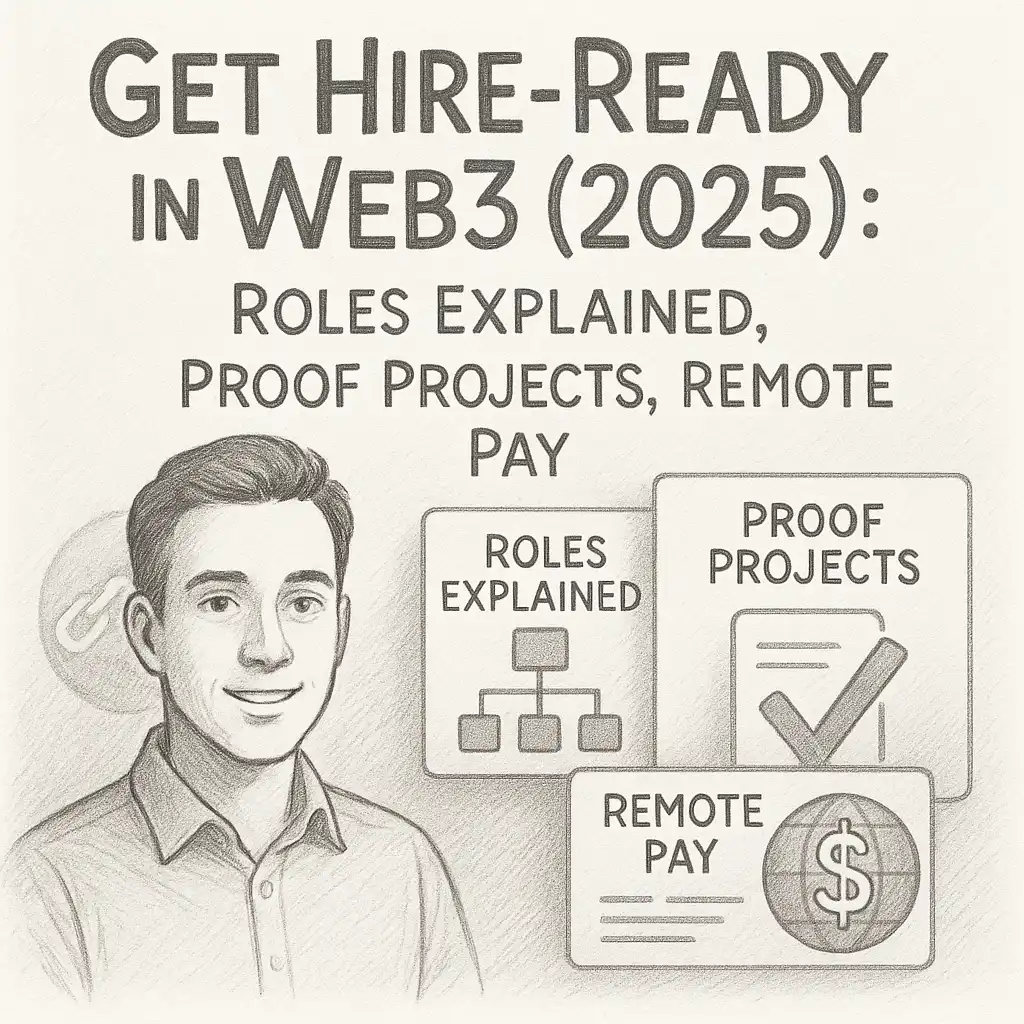
What Does a “Blockchain Career” Actually Mean?
When people hear “blockchain career,” most imagine a coder staring at Solidity or Rust all day. That’s partly true — developers are crucial — but blockchain as an industry is much wider. Think of it like the early internet: the web wasn’t just built by engineers; it grew because writers, designers, legal experts, marketers, and product managers made it usable and trusted.
A blockchain career simply means contributing to a decentralized system — whether by writing code, designing a wallet UI, managing compliance for crypto payments, or building a community around an ecosystem. The skills might differ, but the goal remains the same: to help decentralized networks work safely, clearly, and at scale.
If you’re new and wondering where to begin, check out these community discussions. Both explain how to move from curiosity to career clarity — even without a coding background.
https://artofblockchain.club/discussion/new-to-blockchain-seeking-guidance https://artofblockchain.club/discussion/where-to-start-newbie-in-blockchain.
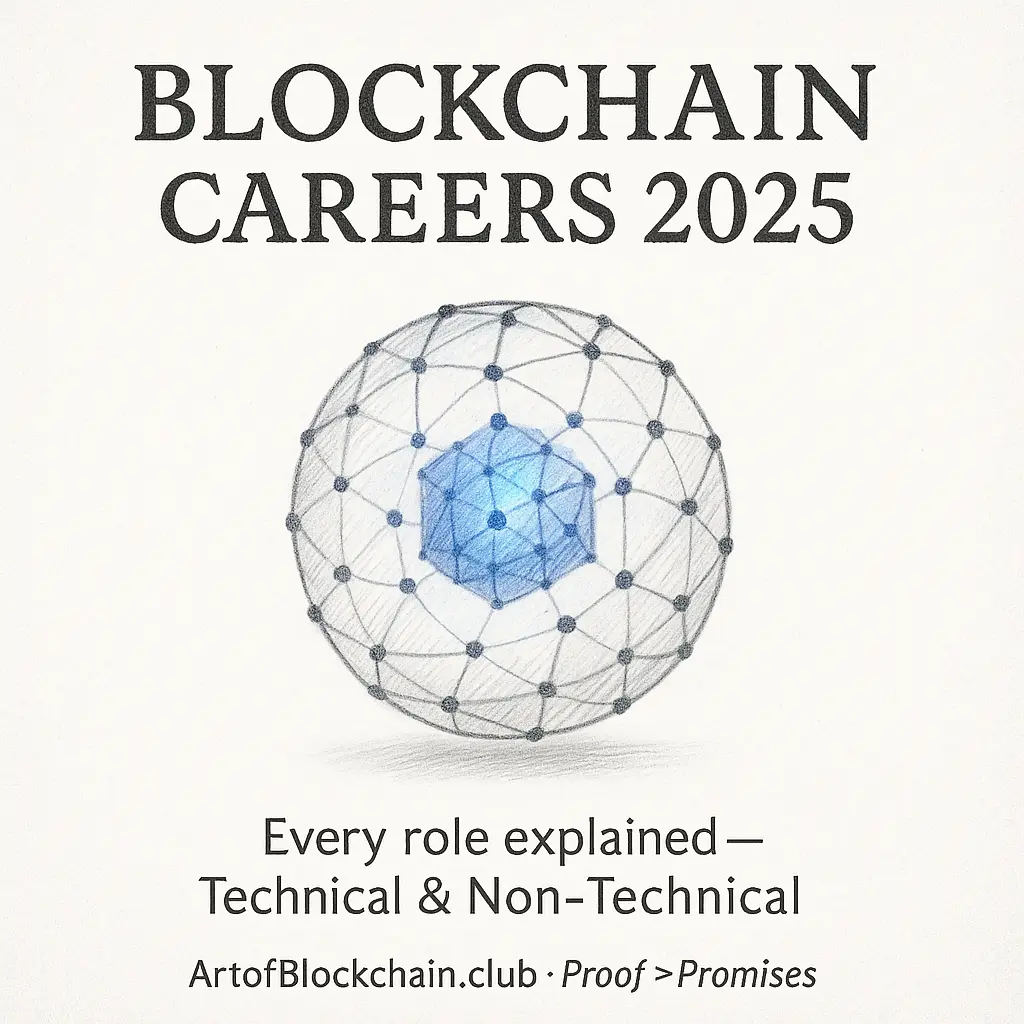
For instance, Ethereum alone has millions of users and contributors. According to the Electric Capital Developer Report, over 20,000 monthly active developers work across Web3 ecosystems. Still, the ecosystem also includes researchers, auditors, educators, recruiters, and content creators who keep those systems functional and growing.
So whether you love product strategy, legal structures, storytelling, or UX, there’s space in blockchain for you. You don’t need to “code” to build in Web3, you just need to understand how decentralized systems change the way we create, share, and verify information.
You can explore the fundamentals here
What Is Web3 Experience? Key Web3 Basics Every Job Seeker Should Know
A blockchain career is any role that helps decentralized systems run, scale, and gain trust — not just coding.
The Ecosystem at a Glance — Technical vs Non-Technical (and Where They Overlap)
Broadly, blockchain careers fall into two lanes: technical and non-technical — though the line between them is fading fast.
Technical roles include developers, auditors, DevOps engineers, and protocol researchers. They design smart contracts, maintain blockchain nodes, and ensure security. To explore the builder’s side, Ethereum.org’s developer portal gives a great hands-on overview. These roles require comfort with tools such as Solidity, Rust, Hardhat, and dApp integration frameworks.
But on the other side, non-technical roles power how those technologies reach the world. Product managers translate technical concepts into user needs. Community managers grow loyal user bases. Legal and compliance experts navigate evolving crypto regulations. UX/UI designers make decentralized apps usable for everyday people.
Where these worlds overlap is where career opportunities grow fastest. For example, a product manager with enough technical fluency to discuss gas optimization, or a designer who understands wallet interaction flows, becomes irreplaceable. The same applies to marketers who can explain token utility or risk teams who understand smart contract vulnerabilities.
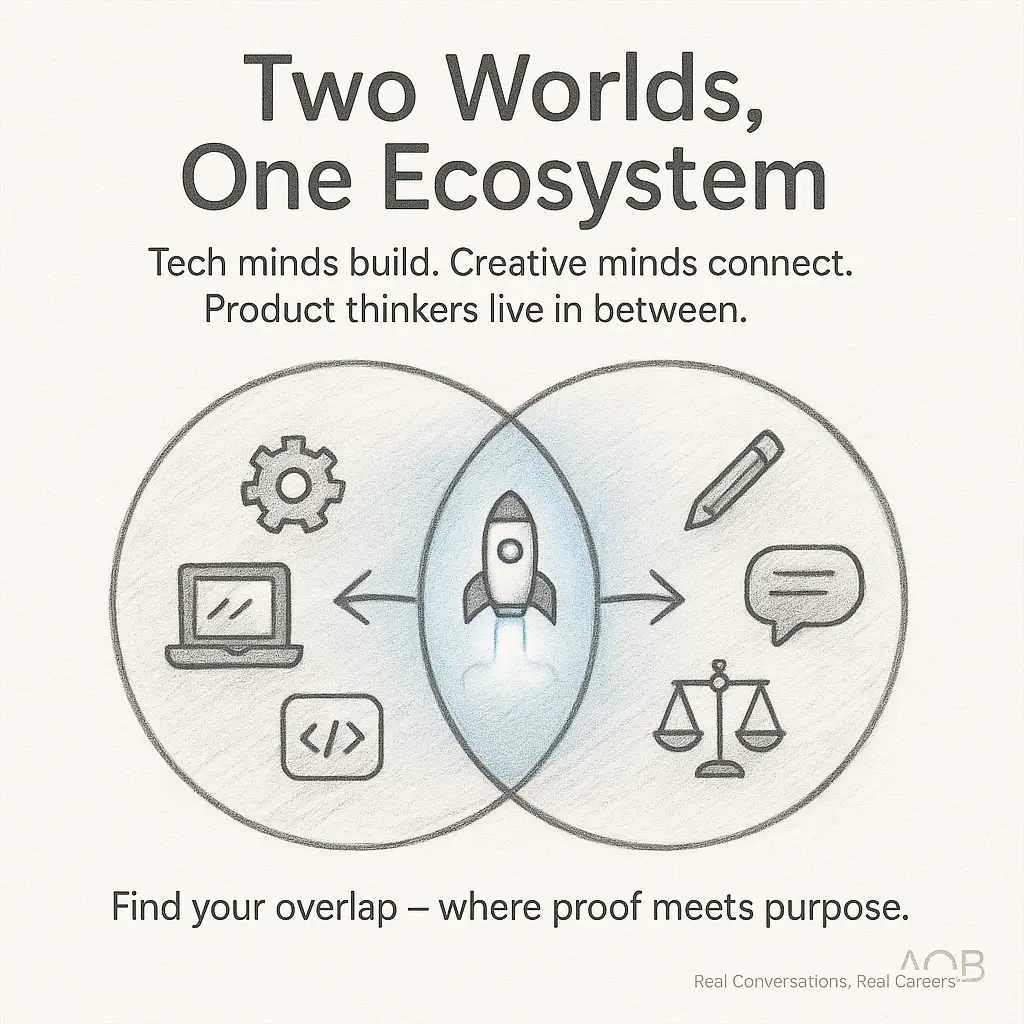
Students can start small — analyzing case studies, joining open communities, or contributing to documentation — to build proof of skill across both sides.
If you’re unsure which lane fits you, start here
Where to start? Newbie in Blockchain for practical direction.
Technical and non-technical roles both drive blockchain forward, and the most impactful professionals understand a bit of both.
Role-by-Role Explainers (For Beginners)
(1) Smart Contract Developer
A Smart Contract Developer writes and deploys the code that automates trust on blockchain networks. These self-executing programs run on platforms like Ethereum, Solana, or Avalanche, handling everything from NFT minting to DeFi lending logic. Developers in this role turn business rules into transparent, immutable logic.
They work with languages like Solidity, Rust, or Move and frameworks such as Hardhat, Foundry, and Truffle. They also handle deployment, testing, and on-chain interactions.
You can learn the foundational roadmap in How to Become a Blockchain Engineer
or practice EVM basics with this quiz https://artofblockchain.club/quiz/what-is-the-evm.
Starter skills/tools: Solidity, Remix IDE, GitHub, Hardhat.
External reference: Ethereum Developer Docs .
If you enjoy turning logic into real-world automation, Smart contract developer role fits you.
(2) Smart Contract Auditor
Smart Contract Auditors are blockchain’s “ethical hackers.” They review deployed or upcoming smart contracts to find vulnerabilities, logic errors, or exploits that could cost millions. Their job blends software security and blockchain expertise, ensuring that code truly behaves as intended.
They often use static analysis tools like Slither or Mythril and manual review techniques to catch what automated scanners miss.
A great primer is our article Smart Contract Audits: Your Code’s Essential Security Check
and you can explore real interview cases here
How to Answer Common Smart Contract Security Mistakes in Blockchain Auditor Interviews
Starter skills/tools: Solidity, Foundry, Mythril, Echidna.
External reference: Chainalysis Crypto Crime Report .
If you enjoy breaking things before attackers can, Smart contract Auditor role fits you.
(3) Protocol Engineer
A Protocol Engineer works on the foundations of blockchains like consensus algorithms, peer-to-peer networking, and scalability features such as sharding and zk proofs. These engineers help define how nodes communicate and agree on new blocks. It’s deep, complex work that shapes how the blockchain itself evolves.
They code primarily in low-level languages such as Rust, Go, or C++, and often contribute to open-source repositories for Layer 1 and Layer 2 systems.
To see how this work connects to developer jobs, check our guide Rust vs Solidity — Which Has Better Blockchain Job Opportunities?.
Starter skills/tools: Rust, Go, Git, cryptography basics.
If you enjoy systems-level problem-solving and care about performance, Protocol role fits you.
(4) Full-stack dApp Developer
Full-stack dApp Developers bridge Web2 and Web3. They build user-facing decentralized apps that connect to blockchain smart contracts via wallets like MetaMask or WalletConnect. This role demands both front-end fluency (React, Next.js) and on-chain integration know-how.
They manage APIs, gas cost optimization, and UX issues like wallet prompts.
Our thread on MetaMask Integration Tips for React Developers shows how traditional developers can make the switch smoothly.
Starter skills/tools: React, Web3.js or Ethers.js, MetaMask, APIs.
External reference: Ethereum Developer Portal.
If you enjoy seeing your code come alive in real user interfaces, Full-stack Dapp Developer role fits you.
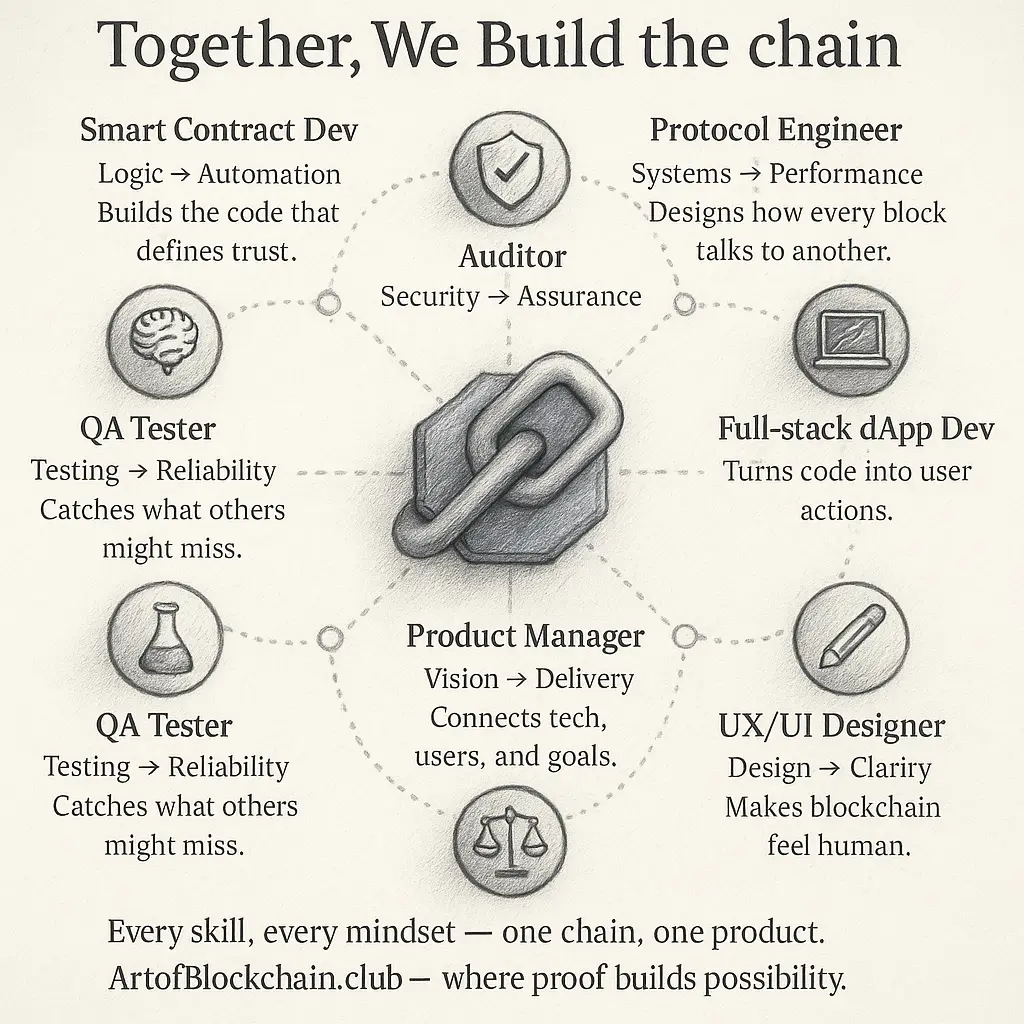
(5) Blockchain QA Tester
A Blockchain QA Tester ensures everything in decentralized systems works as expected — from transactions and wallets to smart contract integrations. Unlike traditional QA, blockchain testing involves on-chain logic, gas limits, and network behavior.
QA testers write automation scripts, test transactions on testnets, and simulate failure conditions like reentrancy or network forks.
To see how QA roles differ in Web3, read How Blockchain QA Analysts Think
Starter skills/tools: Postman, Hardhat tests, Ganache, API validation.
If you love finding hidden issues before users do, Blockchain QA tester role fits you.
(6) Product Manager (Web3)
A Web3 Product Manager connects the technical and human sides of blockchain products. They define features, gather community feedback, and translate complex protocol behavior into clear product experiences.
They collaborate with engineers, designers, and legal teams while tracking token models and roadmap dependencies. Beginners can explore fundamentals in What Is Web3 Experience?.
Starter skills/tools: Notion, Jira, analytics tools, and basic Solidity knowledge.
External reference: Chainalysis Web3 Adoption Insights .
If you enjoy connecting users, teams, and code into one story, Product manager (Web3) role fits you.
(7) Community / Growth Manager
A Community Manager builds trust and engagement around a blockchain ecosystem. They handle Discord, Telegram, and X (Twitter) communities — hosting AMAs, moderating discussions, and tracking sentiment. Growth managers turn these interactions into measurable adoption.
They also coordinate with content teams, organize campaigns, and use analytics tools to monitor engagement. See our beginner guide New to Blockchain: Seeking Guidance for an entry path to Web3 communities.
Starter skills/tools: Discord, Notion, analytics dashboards, basic DeFi knowledge.
If you enjoy connecting people and turning conversations into movement, community manager role fits you.
(8) Compliance / Risk / Forensics Analyst
Compliance Analysts help projects follow global crypto laws and detect suspicious transactions. They assess token structures, perform KYC/AML checks, and investigate illicit activity on-chain. This role combines finance, regulation, and technical literacy.
They use blockchain analytics tools to trace funds and prepare risk reports. Learning from the Chainalysis and Elliptic ecosystems gives an edge for forensic-level work.
Starter skills/tools: Chainalysis, Elliptic, KYT, Excel, and report writing.
If you like the intersection of law, logic, and transparency, compliance analyst role fits you.
(9) UX/UI Designer for Web3
A UX/UI Designer ensures decentralized apps don’t feel complicated. They design intuitive wallet flows, transaction confirmations, and dashboards that make on-chain actions easy for non-technical users.
They collaborate closely with developers and product managers to balance visual clarity with technical accuracy.
For inspiration, explore our discussion:
How can I create a strong Web3 UI/UX design portfolio?
Starter skills/tools: Figma, Framer, UX research, wallet design principles.
External reference: Ethereum UX research section .
If you love simplifying complexity through design, UX/UI role fits you.
How to Choose Your First Path
Choosing your first blockchain path can feel like standing at a crossroad — every direction sounds exciting, but you can’t explore all of them at once. The trick is to start with your curiosity, not job titles. Ask yourself what kind of problems you enjoy solving.
If you like building and debugging, explore technical roles like Smart Contract Developer or QA Tester. If you enjoy explaining, organizing, or analyzing, try Product, Community, or Compliance paths.
Read our discussion Projects That Can Help Me Land a Junior Blockchain Developer Job
to see how even small, guided projects can help you discover your fit.
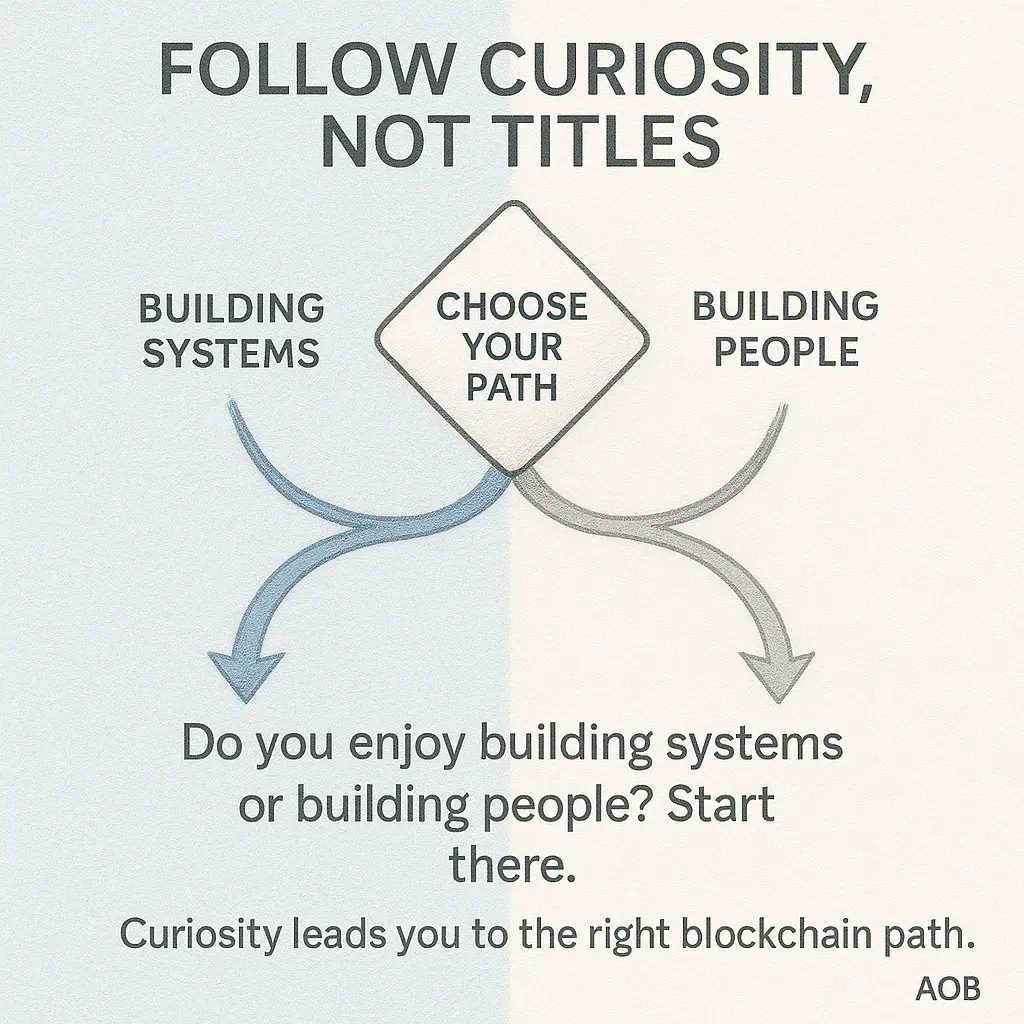
Step 1: Identify Your Comfort Zone
List your current strengths — design, writing, coding, research, or marketing. Match them to blockchain roles. For example, writers can help projects explain token models; developers can build wallet prototypes.
Step 2: Learn by Observation
Follow ecosystems like Ethereum, Solana, or Polygon. Study open-source GitHub repos to see real-world code, or follow design and governance discussions on forums. Visit Ethereum.org Learn for foundational learning paths that connect concepts with hands-on resources.
Step 3: Don’t Rush Specialization
In your first 1–2 months, try to understand multiple aspects of blockchain. Experiment with writing a simple contract, joining a community call, or analyzing a dApp’s UX. You’ll naturally gravitate toward one area where learning feels playful, not forced.
Choose your first blockchain path by following curiosity, not job titles. Explore multiple angles before narrowing focus.
Your First 30–60 Days: Quick Starter Kit
The first two months are not about mastery — they’re about momentum. Think of this as your “orientation phase” into the blockchain ecosystem.
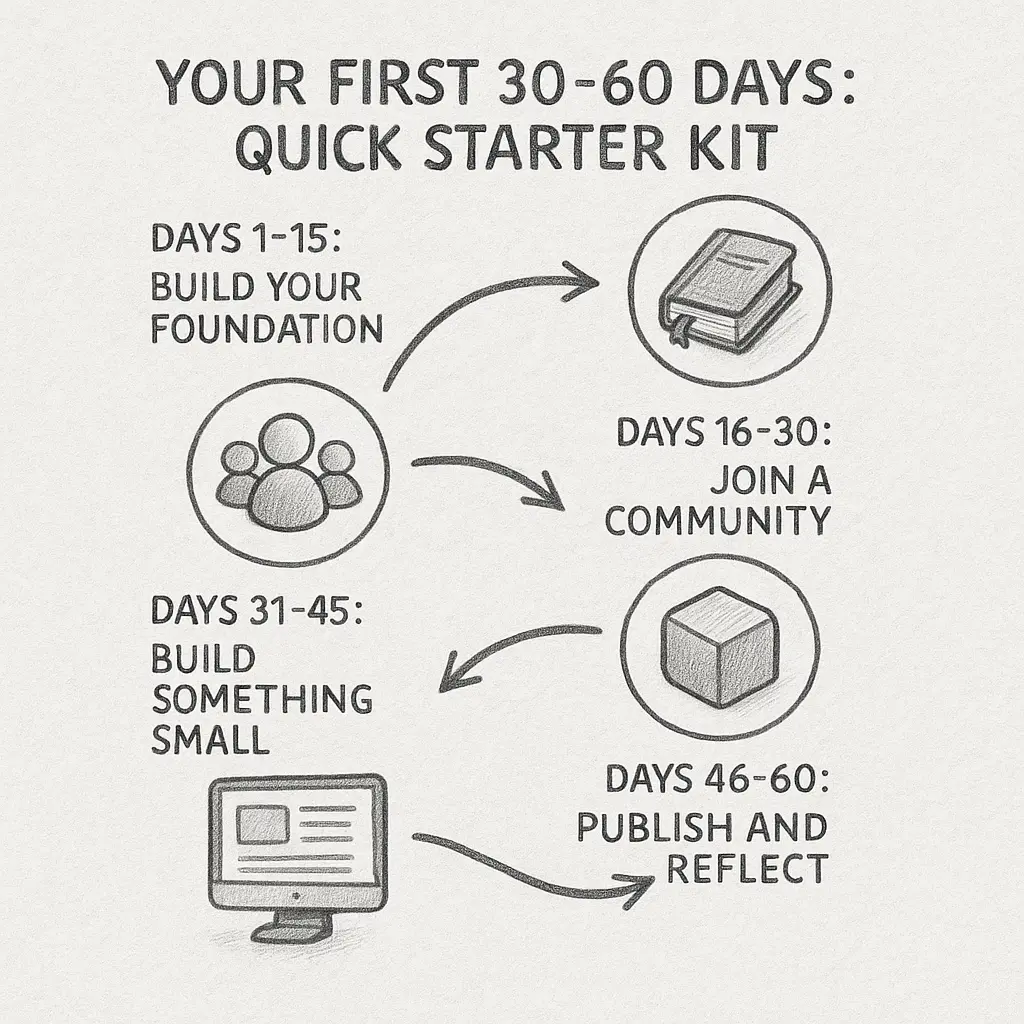
Days 1–15: Build Your Foundation
Start by learning the fundamentals — what a blockchain does, how transactions are verified, and how wallets interact with smart contracts.
Take short quizzes to test understanding, like A Smart Contract Is...
or What Does OpenZeppelin Provide?.
If you’re still getting comfortable with technical terms, our thread on
Best Ways to Gain Hands-On Blockchain Experience for Beginners can help you start experimenting safely using testnets and sandbox tools.
Days 16–30: Join a Community
Participate in forums and Discords — not to “network,” but to observe how problems are discussed and solved. Try commenting on threads or joining community tasks. When you add thoughtful comments or small contributions, you start building credibility.
Days 31–45: Build Something Small
Use your growing knowledge to create a proof-of-concept — a mini NFT drop, a Solidity calculator, or a research summary comparing two protocols. Even a documentation rewrite or UX critique counts as a valid contribution.
Beginners often find project ideas in Projects That Can Help Me Land a Junior Blockchain Developer Job.
Days 46–60: Publish and Reflect
Once you’ve made something no matter how simple — document it. Create a one-page write-up with screenshots, GitHub links, and lessons learned.
Then, organize it on your own portfolio page using our guide Building a Blockchain/Web3 Portfolio Site.
By day 60, your goal isn’t to “become an expert.” It’s to have visible proof that you can learn, apply, and share blockchain knowledge.
In your first 60 days, focus on small, visible actions — learning, joining, building, and sharing.
What ‘Proof’ Means for Beginners (and How to Build It)
In blockchain careers, proof replaces promises. Employers and recruiters don’t just trust résumés — they look for visible signs of what you’ve done. Proof can be a GitHub repo, a quiz score, a discussion post, or even a screenshot of your deployed contract.
Step 1: Redefine “Experience”
You don’t need a job title to show experience. Completing a tutorial on Remix, joining an open-source task, or solving quiz challenges already demonstrates initiative. Use small wins to build public proof — even testnet projects count.
Check our thread on Best Ways to Gain Hands-On Blockchain Experience for Beginners for structured ideas.
Step 2: Create Public Artifacts
Turn your learning into something shareable — like a mini case study on LinkedIn or a portfolio blog. You can outline your process, tools used, and what you learned. Use this structure from Building a Blockchain/Web3 Portfolio Site to organize it.
Step 3: Combine Learning + Doing
Pair theory with micro-projects. For instance, after studying smart contracts, take the quiz A Smart Contract Is... (https://artofblockchain.club/quiz/a-smart-contract-is), then deploy one on a testnet. After learning about OpenZeppelin libraries, take the quiz What Does OpenZeppelin Provide? (https://artofblockchain.club/quiz/what-does-openzeppelin-provide) and use them in your code. These quick cycles of learn–apply–show are how blockchain hiring works.
Step 4: Seek Feedback
Post your small projects in open communities like AOB. Ask for feedback on your code, visuals, or research summaries. Recruiters and senior devs often notice consistency — not perfection. Every genuine contribution helps build reputation and “proof of work.”
Step 5: Keep Iterating
Proof grows like compound interest. The more you build and share, the easier it becomes to get invited into projects or part-time gigs. In decentralized ecosystems, visibility equals credibility.
Proof in blockchain means showing consistent, verifiable effort — not waiting for someone’s permission to start.
Demand & Salary Snapshot (Junior to Mid-Level)
The blockchain job market continues to expand — but unlike the 2021 hype era, today’s demand is skill-driven, not speculative. Companies now prioritize developers, auditors, and product professionals who can demonstrate proof of real contributions, not just certification badges.
Reports from Web3.career Salary Index and Crypto Recruiters Salary Guide show that even junior-level salaries in blockchain roles remain above most Web2 equivalents due to niche technical knowledge and global hiring models.
Here’s an approximate snapshot of current averages (as of Q4 2025):
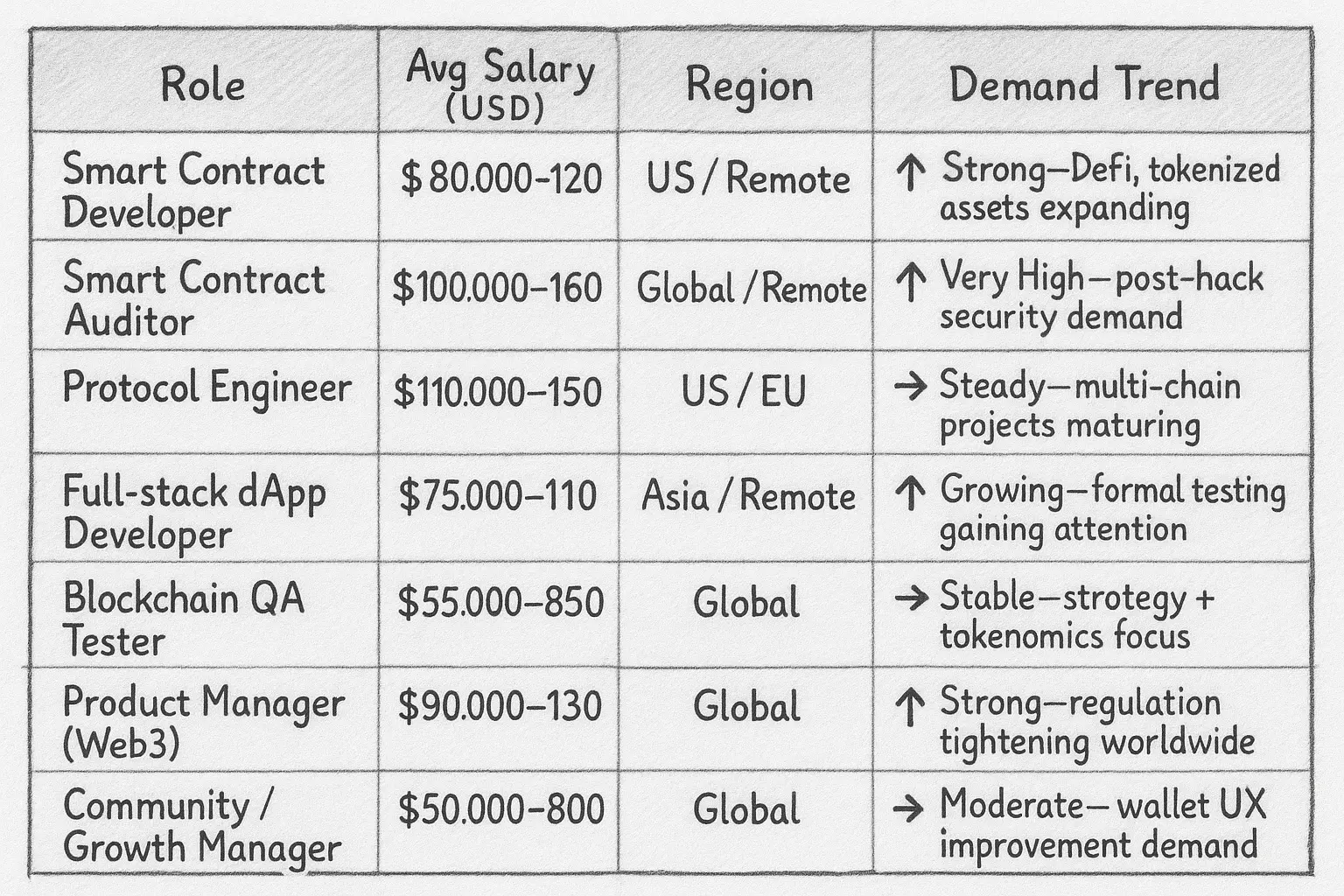
What’s Driving These Numbers?
Security is king. Hacks and exploits have pushed smart contract auditors and risk analysts to the top of salary charts.
Proof-based hiring. Recruiters now prioritize candidates with GitHub repos or verifiable testnet work — not just certificates.
Cross-chain fluency. Engineers comfortable with both EVM and non-EVM ecosystems (like Solana or Cosmos) are in high demand.
Community-first products. Startups invest heavily in community/growth teams who can balance marketing with authenticity.
To understand which technical or soft skills are fueling these trends, explore our deep-dive
Top 10 In-Demand Blockchain Skills and Associated Job Roles for 2025.
The blockchain job market rewards proof, adaptability, and hybrid skill sets that merge coding, communication, and compliance.
🪙 Emerging Blockchain Roles in 2026: What’s Coming Next
Blockchain careers won’t look the same two years from now.
As AI, regulation, and data verification converge, a new generation of hybrid blockchain jobs is already emerging. These aren’t replacements for developers or auditors — they’re extensions of how blockchain integrates with everyday systems.
1️⃣ AI x Blockchain Data Engineer
As AI models depend on clean, verifiable data, this role ensures datasets are traceable and tamper-proof using blockchain ledgers. These engineers design pipelines where data sources can be verified before entering AI workflows.
Starter skills: Python, Rust, data engineering, cryptography.
Proof idea: Contribute to small open-source tools combining on-chain data with AI models or write analysis posts on AI-chain use cases.
2️⃣ Tokenomics & Mechanism Design Analyst
The next wave of DeFi and gaming projects will need specialists who understand user incentives, staking design, and economic sustainability. Tokenomics analysts simulate how supply, burn rates, and user rewards shape project longevity.
Starter skills: Spreadsheet modeling, basic Solidity, game theory, data visualization.
Proof idea: Analyze existing token models on ArtofBlockchain.club discussions (https://artofblockchain.club) or publish small “token model breakdowns.”
3️⃣ Blockchain Policy & Compliance Consultant
As jurisdictions like the EU (MiCA) and India’s VDA regime mature, consultants will bridge the gap between innovation and regulation. They’ll help projects design compliant token launches, handle global reporting, and understand cross-border KYC frameworks.
Starter skills: Chainalysis tools, crypto-law basics, risk reporting.
Proof idea: Write comparative case notes on evolving crypto regulations or participate in compliance discussions on AOB.
By 2026, blockchain jobs will move beyond pure tech — rewarding professionals who can translate code, compliance, and communication into trust.
🌍 How Remote Blockchain Hiring Works (and What It Means for You)
Blockchain was born remote, long before “remote work” became trendy.
Today, more than 80% of Web3 projects hire contributors across continents, judging proof instead of proximity. Understanding how remote hiring works helps you reach global opportunities without relocating.
1️⃣ Proof Over Presence
Recruiters in blockchain don’t care about time zones — they care about proof. A visible GitHub repo, quiz score, or forum contribution speaks louder than a résumé.
Start by showcasing your early work through AOB discussions or by linking small testnet projects on your portfolio.
2️⃣ Global Pay Bands, Local Lifestyles
Remote pay usually mirrors skill, not geography. A Solidity developer in India may earn $70K–$90K (≈₹60–75 LPA), while senior auditors can cross $150K remotely. Salaries align more with reputation + proof than with office hours.
For context, refer to the global averages from Web3.career Salary Index (https://web3.career/salaries).
3️⃣ DAOs, Bounties & Async Workflows
Modern teams hire through open bounties and short-term gigs instead of traditional HR routes. DAOs, Gitcoin, and community forums assign micro-tasks — ideal for beginners building portfolios. These proof-based contributions often convert into full-time roles once consistency is visible.
4️⃣ Communication Is the New Resume
Remote blockchain teams thrive on clarity. Clear writing in docs, discussions, and PRs shows maturity and collaboration. Being active (not noisy) in communities can fast-track you to serious recruiter attention.
Blockchain hiring is now borderless and merit-based. Proof, clarity, and contribution outweigh location — and AOB’s open discussions are the best way to start showing all three.
FAQs
1. Do I need a CS degree to get into blockchain?
Not at all. Many professionals come from finance, design, or operations backgrounds. What matters most is your proof of work — small projects, contributions, and verified learning.
2. How can I switch from Web2 to Web3 without losing time or income?
Start by identifying transferable skills and gradually experimenting with blockchain tools. Read our full guide How to Transition from Web2 to Web3 Jobs Swiftly & Strategically.
3. Are internships common in blockchain?
Yes — but they’re often informal, remote, and contribution-based. Check our discussion How to Get a Blockchain/Web3 Internship or Job as a Fresher for entry routes used by students and freshers.
4. Which blockchain ecosystems hire beginners the most?
Ethereum, Solana, and Polygon remain the most beginner-friendly due to large documentation bases and open communities. See Ethereum.org Learn (https://ethereum.org/en/learn/) for starter materials.
5. What’s the fastest way to show proof to recruiters?
Publish one small project or write-up every month. Use public repos, quizzes, or documentation edits as your visible learning log — recruiters love consistent learner
Your degree doesn’t matter — your visible progress does. Proof outweighs pedigree in Web3.
Where to Go Next
If you’ve reached this point, you already understand that blockchain careers are built on proof, not promises. The next step is simple: start building your visible footprint.
Step 1: Pick a Learning Focus
Use this blog and the skills article (https://artofblockchain.club/article/top-10-in-demand-blockchain-skills-and-associated-job-roles-for-2025) to shortlist one technical and one non-technical area that excite you — for example, Solidity + Product Strategy or Design + Compliance.
Step 2: Build One Small Project
Try deploying your first smart contract, designing a wallet flow, or analyzing a DeFi product’s risk model. Use our discussion Projects That Can Help Me Land a Junior Blockchain Developer Job (https://artofblockchain.club/discussion/projects-that-can-help-me-land-a-junior-blockchain-developer-job) for ideas.
Step 3: Create Your Portfolio
Document everything — your process, screenshots, and what you learned. Follow the Portfolio Site Guide (https://artofblockchain.club/discussion/building-a-blockchainweb3-portfolio-site-sections-case-studies-and-metrics) to structure your work like a mini case study.
Step 4: Engage With Communities
Comment on threads, give feedback, and ask open-ended questions on platforms like ArtofBlockchain.club (https://artofblockchain.club). Real discussions build visibility and confidence faster than any course.
Step 5: Stay Updated
Follow credible reports such as Chainalysis and LinkedIn’s Jobs on the Rise 2025 . This helps you align your learning path with what recruiters will need next quarter — not last year.
Final Takeaway
The blockchain industry rewards self-starters, proof builders, and community participants. Every comment, project, or quiz attempt compounds into credibility. Whether you’re a student, a designer, or a QA tester — start small, stay consistent, and let your proof speak louder than your profile.
Join real discussions at ArtofBlockchain.club (https://artofblockchain.club) — where jobs are built on proof, not promises.
Author: Shubhada Pande
Founder, Artofblockchain.club